Class 12 Economics Solved Paper (2012 Delhi Set-I) | Additional Study Material for Commerce PDF Download
Ques 1: Give meaning of an Economy.
Ans: It is a system in which goods and services are produced, sold and bought in a country or region through which people get their living.
Ques 2: What is market demand?
Ans: Market demand for a good is the sum total of demands of all the consumers in a market at a particular price during a given period of time.
Ques 3: What is behaviour of average fixed cost as output increases?
Ans: Average Fixed Cost refers to the fixed cost per unit of output produced. It is derived by dividing the Total Fixed Cost by quantity of output. That is, 
As output increases, the average fixed cost (AFC) falls.
Ques 4: What is the behaviour of average revenue in a market in which a firm can sell more only by lowering the price?
Ans: AR curve slopes downward in a market in which firm can sell more only by lowering price.
Ques 5: What is a price taker firm?
Ans: A price taker firm is the firm which does not have any control over the existing market price and cannot influence it. A firm in a perfectly competitive market is regarded as a price taker firm.
Ques 6: Given price of a goods, how does a consumer decide as to how much of the good to buy?
Ans: In order to decide, how much of a good to buy at a given price, a consumer compares Marginal Utility (MU) of the good with its price (P). The consumer will be at equilibrium, when the Marginal Utility of the good will be equal to the price of the good.
i.e., MUx=Px
If MUx>Px that is, when price is lesser than the Marginal Utility, then the consumer will buy more of that good.
On the other hand, if MUx<Px that is, when price is more than the Marginal Utility, then the consumer will buy less of that good. This is reflected in the following diagram.
Ques 7: Draw Average Variable Cost, Average Total Cost and Marginal Cost curves in a single diagram.
Ans:
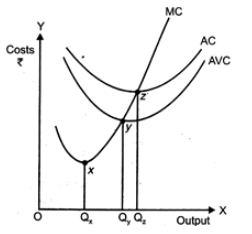
Ques 8: An individual is both the owner and the manager of a shop taken on rent. Identify implicit cost and explicit cost from this information. Explain.
Ans: In this case the implicit cost consists of imputed value of the owner s (manager's) services and the explicit cost consists of the rent paid for the shop.
Implicit cost (Imputed cost) refers to cost of the factor that a producer neither hires nor purchases. Such costs are not actually paid by the producers yet are included in the cost of production. It is a difference between the economic profit and accounting profit. On the other hand, explicit costs are those costs that are borne directly by a firm and are paid to the factors of production. Another way of distinguishing the two is that while explicit costs are referred to as out - of - pocket expenses, on the other hand, implicit costs do not result in any cash outlay from the business. Thus, in the case given, the rent for the shop is to be paid by the firm, so it is considered as explicit cost, while, the costs of owner's service are considered as implicit costs, as no cash is expended for hiring such services.
Ques 9: Explain the implication of large number of sellers in a perfectly competitive market.
Or
Explain why firms are mutually interdependent in an oligopoly market.
Ans: There exist a large number of buyers and sellers in a perfectly competitive market. The number of sellers is so large that no individual firm owns the control over the market price of a commodity. Due to the large number of sellers in the market, there exists a perfect and free competition. A firm acts as a price taker while the price is determined by the invisible hands of market, i.e., by demand for and supply of goods. Thus, we can conclude that under perfectly competitive market, an individual firm is a price taker and not a price maker.
Or
Oligopoly market structure consists of only a few firms. The firms under such a market structure experience a high degree of mutual interdependence. This is because the price and the output decisions of the firms are interdependent on each other. The price and output policy of a firm affects the policies and profit of another firm. This is because when one firm lowers (rises) its prices, the rival firms may or may not follow suit. This makes the demand curve under the oligopoly market structure indeterminate, thereby -makes the firms mutually interdependent in an oligopoly market.
Ques 10: Define an indifference curve. Explain why an indifference curve is downward sloping from left to right.
Ans: Indifference curve is a curve that depicts various combinations of two goods that provides a consumer with the same level of satisfaction.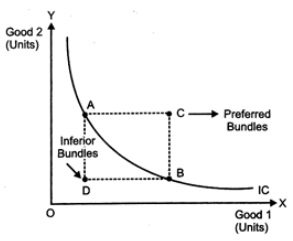
In the above figure, IC is the Indifference Curve. Each bundle on the IC shows those combinations of two goods that yield the consumer the same level of satisfaction.
An indifference curve is downward sloping from left to right. It implies that a consumer cannot simultaneously have more of both the goods. An increase in the quantity of one good is associated with the decrease in the quantity of the other good. This is in accordance with the assumption of monotonic preferences.
Ques 11: When price of good is Rs. 7 per unit a consumer buys 12 units. When price falls to Rs. 6 per unit he spends Rs. 72 on the good. Calculate price elasticity of demand by using the percentage method. Comment on the likely shape of demand curve based on this measure of elasticity.
Ans:
| Quantity (Q) | Price (P) | Total Expenditure (TE) |
| 12 | Rs. 7 | 84 |
| 12 | Rs. 6 | 72 |
We know
Price × Quantity = Total Expenditure
or, 6 × Quantity = 72
or, Quantity =12
Now,
Percentage change in quantity
Percentage change in price
Substituting the values in the formula of price elasticity of demand,
Thus, the demand is perfectly inelastic.
As the demand is perfectly inelastic, so the demand curve is a vertical straight line parallel to the price - axis.
Ques 12: What does the Law of variable Proportions show? State the behaviour of total product according to this law.
Or
Explain how changes in prices of other products influence the supply of a given product.
Ans: According to this law, if more and more units of variable factor (labour) are combined with the same quantity of fixed factor (capital) then, initially the total product will increase. However, after a certain point of time, total product will start declining.
Assumptions of Law of Variable Proportions
(i) Technology level remains constant
(ii) The units of variable factors are homogeneous
(iii) One of the inputs must be fixed
(vi) No change in the input prices - wages and interests.
Behaviour of TP
| Stages | Stage?s Name | TP | Range |
| I | Increasing Returns to a factor | TP increases at an increasing rate till K | From 0 to point K |
| II | Diminishing Returns to a factor | Increases at a decreasing rate and attains maximum | From K to point B |
| III | Negative Returns to a factor | TP starts to fall | From B onwards |
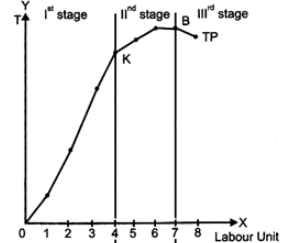
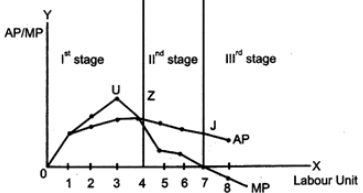
Or
The supply of a given good depends on the price of other goods. In other words, the supply of the good depends on the price of its substitute goods and on the price of its complementary goods. The supply of a given good shares positive (negative) relationship with the price of its substitute goods (complementary goods).
In case of substitute goods: If the price of the substitute goods falls, then the consumer will shift their preference towards that good. As a result, the demand of the good reduces. Consequently, it is not profitable to supply this good, thereby the supply of the good reduces. For example, tea and coffee are substitute goods. If, the price of tea falls, then the supply of coffee will fall.
In Case of complementary goods: If the price of the complementary goods falls, then the consumer will shift their preference towards the given good. This will lead to increase in the demand of the given good. As a result, it becomes profitable to supply more of the good. Thereby, the supply of the good increases. For example, petrol and car are complementary goods. If, the price of petrol falls, then the supply of cars will increase.
Ques 13: Explain how do the following influence demand for a good:
(i) Rise in income of the consumer.
(ii) Fall in prices of the related goods.
Ans: (i) Rise in the income of the consumer: In case of normal goods, a rise in the income of the consumer will increase the demand for the good. This increases leads to the outward parallel shift of the demand curve. However, in case of inferior goods, a rise in the income of the consumer will decrease the demand for the good. This decrease leads to the inward parallel shift of the demand curve.
(ii) Fall in prices of the related goods: Let us suppose that there are two goods X and Y that are perfect substitutes of each other. A fall in the price of say Good Z will lead to fall in the demand for the Good Y and vice-versa. On the other hand, if X and Fare complementary goods, then a fall in the price of Good X will increase the demand for Good Y and vice-versa.
Ques 14: Explain the conditions of a producer's equilibrium in terms of marginal cost and marginal revenue. Use diagram.
Ans: According to MR-MC approach, the producer attains equilibrium where the following two conditions are satisfied
(i) Necessary condition of First Order Condition (FOC)
MR = MC
or
(ii) Sufficient condition or Second Order Condition (SOC)
MC curve is rising and cuts MR curve from belo:
That is, Slope of MC > 0
The conditions are explained below diagrammatically. 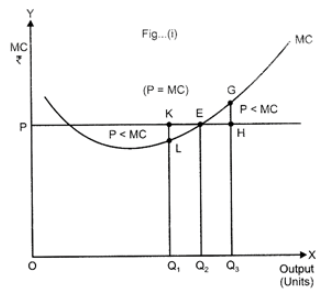
(i) Condition 1: MR = MC
If price is greater than the MC the firm can increase profit by increasing the production. In figure (i) At output OQ1, price is KQ1 and the marginal cost is LQ1, such that KQ1 >LQ1. Therefore, OQ1 is not the profit maximizing output. This is due to the fact that the firm can increase its profit by increasing the production of output to OQ2
On the other hand, if price is less than MC the firm can increase profit by lowering the production. At output OQ3, price is HQ3 and the marginal cost is GQ3, such that HQ3 <GQ3. Therefore, OQ3 is not the profit maximizing output. This is because the firm can increase its profit by reducing its output level toOQ2.
(ii) Condition 2: MC curve should be rising at the point of intersection with MR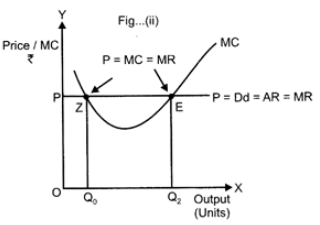
In the diagram, the MC curve cuts the price line (or MR) at two different points i.e., at ?Z5 and ?E5. The first order condition of profit maximization, i.e. Price (or MR = MQ is fulfilled at both these points.
At Point Z: MC is falling and is negatively sloped. Any slight increase in the output would imply that the price exceeds MC. This implies that the firm can increase profit by increasing the production.
At Point E: MR is equal to MC and also MC is rising. Any deviation from this point results in a lowering of profit for the firm. Thus, both the first order condition (MR = MQ and the second order condition (MC curve should be rising at the point of intersection with MR) are satisfied at point E. Hence, point E is the equilibrium point.
Ques 15: Market for a good is in equilibrium. There is simultaneous 'increase' both in demand and supply of the good. Explain its effect on market price.
Or
Market for a good is in equilibrium. There is simultaneous "decrease" both in demand and supply of the good. Explain its effect on market price.
Ans: The simultaneous increase in demand and supply affects the equilibrium price and output depending on the magnitude of the change in demand and supply. The simultaneous increase in the demand and supply can be bifurcated into the following three conditions.
(i) When Demand and Supply Increase in the Same Proportion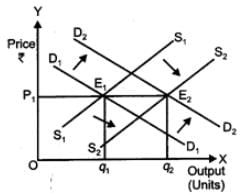
According to the diagram, E1 is the initial equilibrium with equilibrium price P1 and equilibrium output q1.
Now let us suppose, the demand increases to D2D2 and the supply increases to S2S2 by the same proportion to that of demand. The new demand curve and the new supply curve intersect at point E2, which is the new equilibrium point.
At the new equilibrium point, new equilibrium output isoq2 while the equilibrium price remains the same ato P1.
Thus, an increase in the demand and the supply by same proportion leaves the equilibrium price unchanged.
(ii) When Demand Increases More than Increase in Supply
The initial demand curve and the initial supply curve intersect each other at point E1, with initial equilibrium price oP1 and initial equilibrium output oq1.
Now let us suppose that, demand increases and thereby demand curve shifts to D2D2. Simultaneously, the supply also rises and the supply curve shift to S2S2. However, the increase in the supply is less than the increase in the demand. The new supply curve and the new demand curve intersect each other at point. E2, with higher equilibrium priceoP2 and higher equilibrium output oq2.. Thus, when the demand increases more than the increase in supply, the equilibrium price rises.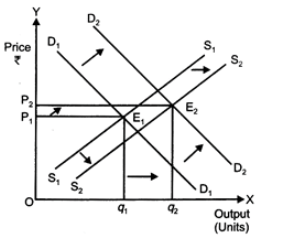
(iii) When Demand Increases but Lesser than the Increase in Supply
Let the initial equilibrium be at point E1, with the equilibrium price oP1 and the equilibrium outputoq1. Now, suppose that the demand increase toD2D2 and supply increases to S2S2. However, the increase in supply is more than that of the increase in demand. The new demand curve D2D2 and the new supply curve S2S2 intersect at point E2, with lower equilibrium price oP2. Thus, when the increase in demand is less than the increase in supply, the equilibrium price falls.
Or
The simultaneous decrease in demand and supply affects the equilibrium price and output depending on the magnitude of the change in demand and supply. The simultaneous decrease in the demand and supply can be bifurcated into the following three conditions.
(i) When Demand and Supply Decreases in the Same Proportion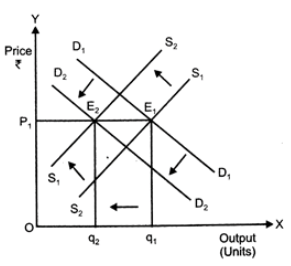
Let S1S1 and D1D1 be the initial supply curve and the initial demand curve respectively. The initial equilibrium is at point E1, with equilibrium price at oP1 and equilibrium output oq1.
Suppose that both demand and supply decrease by the same proportion. Consequently, the demand curve shifts to D2D2 and the supply curve shifts to S2S2. The new equilibrium is at point E2 with lower equilibrium output oq2. but the same equilibrium price oP2. Thus, when both demand and supply decrease in the same proportion, the equilibrium price remains the same, but the equilibrium quantity falls.
(ii) When Demand Decreases More than the Decrease in Supply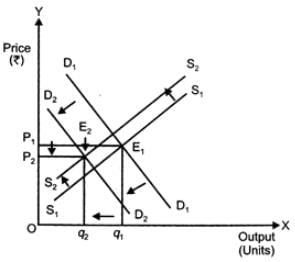
Let D1D1 and S1S1 be the initial demand curve and the initial supply curve, respectively. The initial equilibrium is at pointMisplaced & with equilibrium price P1 and equilibrium output q1.
Now let us suppose that, demand decrease to D2D2 and supply decreases by lesser proportion to S2S2. Consequently, the new equilibrium is established at point E2. At the new equilibrium, the equilibrium price falls to oP2 and equilibrium output falls to oq2. Thus, when decrease in demand is more than the decrease in supply, the equilibrium price falls accompanied by the fall in equilibrium output.
(iii) When Decrease in Demand is Lesser then Decrease in Supply.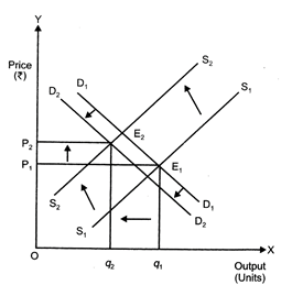
Let the initial equilibrium be at pointE1, determined by the intersection of the initial demand curve D1D1 and the initial supply curve S1S1. The equilibrium price is oP1 and the equilibrium output is oq1.
Now suppose that, the demand decreases but lesser than the decrease in the supply. The demand curve shifts to D2D2 while the supply curve shifts to S2S2. The new equilibrium determined by the intersection of D2D2 and S2S2 is at point E2, where the equilibrium price increases to oP2 and the equilibrium quantity falls to oq2.. Thus, when decrease in demand is lesser then the decrease in supply then the equilibrium price rises and equilibrium output falls to oq2..
Ques 16: Define stock variable.
Ans: A variable whose value is measured at a point of time is called stock variable.
Ques 17: Define capital goods.
Ans: Capital goods are those goods which are used in producing other goods.
Ques 18: What are demand deposits?
Ans: Demand deposits are those deposits which can be withdrawn immediately by issuing cheques.
Ques 19: Define a Tax.
Ans: Taxes are the compulsory payments made by the households and the producing sectors to the government. Taxes as of two types namely, direct taxes (such as income tax) and indirect taxes (such as, sales tax).
Ques 20: Give meaning of managed floating exchange rate.
Ans: A system where the government fix the exchange rate through central bank, it is called managed floating exchange rate.
Ques 21:
Calculate Gross Value Added at Factor Cost: | ||
(i) | Units of output sold (units) | 1,000 |
(ii) | Price per unit of output (Rs.) | 30 |
(iii) | Depreciation (Rs.) | 1,000 |
(iv) | Intermediate cost (Rs.) | 12,000 |
(v) | Closing stock (Rs.) | 3,000 |
(vi) | Opening stock (Rs.) | 2,000 |
(vii) | Excise (Rs.) | 2,500 |
(viii) | Sales tax (Rs.) | 3,500 |
Ans: Gross Value Added at Factor cost (GVAFC) = Total Value of Sales + Change in Stock - Intermediate Consume
GVAFC (orGDPFC) =(1000×30)+(3000−2000)−12000−(3500+2500)
Or, GVAFC = Rs. 13,000
Ques 22: Outline the steps taken in deriving saving curve from the consumption curve. Use diagram.
Ans: In the diagram  +bY is the consumption curve.
+bY is the consumption curve.
The 45∘ line is the aggregate supply curve.
At point E, consumption = income i.e. (Y= )
) represents the autonomous consumption i.e., consumption at zero level of income. Steps for derivation of supply curve from consumption curve as follows:
represents the autonomous consumption i.e., consumption at zero level of income. Steps for derivation of supply curve from consumption curve as follows:
(i) Corresponding to C¯¯¯¯ in the consumption function we have -  in the saving function. That is, there are negative savings equal to autonomous consumption at Y = 0. This is represented by S on the negative axis in the lower panel.
in the saving function. That is, there are negative savings equal to autonomous consumption at Y = 0. This is represented by S on the negative axis in the lower panel.
(ii) At point E (Y= ). This implies that all the income is spent on consumption expenditure. Thus, savings equal to zero. This is shown as S = 0 in lower panel. This point is also known as the Break-even point.
). This implies that all the income is spent on consumption expenditure. Thus, savings equal to zero. This is shown as S = 0 in lower panel. This point is also known as the Break-even point.
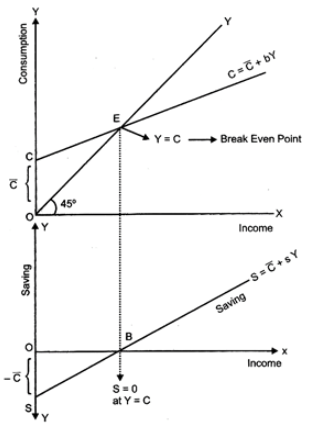
(iii) Beyond the break-even point, by connecting points S and Y we derive the straight upward sloping saving curve.
(iv) SS is the required saving curve.
Ques 23: Find national income from the following:
Autonomous consumption =Rs 100
Marginal propensity to consume =0.80
Investment =Rs. 50
Ans:
C = Rs. 100
MFC (b) = 0.80
I = Rs. 50
At Equilibrium,
Y=C+I
or, Y=  +bY+I
+bY+I
substituting the values,
Y=100+0.8V+50
or, 0.2 Y = 150
or, Y = Rs. 750
∴ National Income = Rs. 750
Ques 24: Distinguish between Revenue Expenditure and Capital Expenditure in a government budget. Give examples.
Or
Explain the role of Government budget in allocation of resources.
Ans:
Basis | Revenue Expenditure | Capital Expenditure |
Creation of Assets | It does not create assets for the government. | It results in the creation of assets. |
Reduction of Liability | These expenditures do not result in the reduction of liability. | These expenditure cause a reduction of the liability of the government |
Example | (a) Interest payments (b) Expenditure on defence | (a) Purchase of shares (b) Expenditure on land, building, etc. (c) Grants by the central government to the state government |
or
In a mixed economy, private enterprises generally have a tendency to allocate resources to only those areas of production which are economically feasible and profitable. They are not guided by the service or welfare motive; in fact they are guided by the price signals. In such a situation, the government through its budgetary policy reallocates resources to maintain a balance between the social objectives of welfare maximization and the economic objective of profit maximization. For example, the government levies taxes on socially harmful goods such as tobacco and provides subsidies for the socially desirable goods such as good grains. Thus, the government through its budgetary policy allocates resources in such a manner as to maintain a balance between the profit motive and the social welfare.
Ques 25: Giving reason explain how should the following be treated in estimating national income:
(i) Expenditure on fertilizers by a farmer.
(ii) Purchase a tractor by a farmer.
Ans: (i) Expenditure on fertilizers by a farmer should not be included in the estimation of National Income. This is because it is an intermediate consumption that a farmer purchases in order to enhance the crop productivity, so that he can sell more output.
(ii) Purchase of tractor by a farmer should be included in the estimation of National Income. This is because it is a part of Gross Domestic Capital Formation.
Ques 26:Explain the components of Legal Reverse Ratio.
Or
Explain 'bankers' banks function of Central bank.
Ans:
A certain minimum fraction of deposits which is legally compulsory for the commercial banks to keep in the form of liquid assets, is known as legal reserve ratio. There are two components of this ratio, those are as follows:
(i) Cash Reserve Ratio (CRR): It is a part of deposits which is kept with central bank as reserve in cash by the commercial banks.
(ii) Statutory Liquidity Ratio (SLR): It is a ratio of deposits which banks have to keep with themselves in the form gold or securities.
Or
Central bank is the apex bank of all the commercial banks and financial institutions in the country. It holds the same relationship with the commercial banks as commercial banks holds with its customer. The central bank accepts deposits from the commercial banks and holds it as reserves for them. The commercial banks are compulsorily required to hold a part of their deposits as reserves with the central bank in accordance with the cash reserve ratio (CRR). In addition to the CRR requirements, the commercial banks hold reserves with the central bank for clearing their settlements with other banks and fulfill their requirements to inter-bank transfers.
Ques 27: Explain 'revenue deficit in a Government budget? What does it indicate?
Ans: Revenue deficit is equal to the excess of total revenue expenditure over the total revenue receipts. In short:
Revenue deficit = Total revenue expenditure -Total revenue receipts
Revenue deficit indicates the extra amount of current expenditure which cannot be met by revenue receipts. This shows the extent of borrowings which are required to meet this deficit. Revenue expenditure increases without a corresponding increase in the revenue receipts, revenue deficit increases and this calls for additional borrowing. This means liability of the government deficit increases and this calls for additional borrowing. This means liability of the government increases.
Ques 28:
Find out (a) National income: | ||
(Rs. crores) | ||
(i) | Factor income from abroadt | 15 |
(ii) | Private Final Consumption Expenditure | 600 |
(iii) | Consumption of fixed capital | 50 |
(iv) | Government Final Consumption | 200 |
(v) | Net current transfers to abroad | (-) 5 |
(vi) | Net domestic fixed capital formation | 110 |
(vii) | Net factor income to abroad | 10 |
(viii) | Net imports | (-) 20 |
(ix) | Net indirect tax | 70 |
(x) | Change in stocks | (-) 10 |
Ans: (a) National Income
= Private final consumption expenditure + Government consumption expenditure + [Net domestic fixed capital formation + Change in stock] - Net imports - Net indirect tax - Net factor income to abroad
= (ii) + (iv) + [(vi) + (x)] - (viii) - (ix) - (vii)
=600+200+[110+(−10)]−(−20)−70−10
=600+200+100+20−70−10
=920−80=Rs. 840 crore
Ques 29: Explain the concept of excess demand? in macroeconomics. Also explain the role of open market operations in correcting it.
Or
Explain the concept of 'deficient demand' in macroeconomics. Also explain the role of bank Rate in correction it.
Ans: Concept of ?Excess Demand?: When the equilibrium level of income is determined after the level of full employment, it is the situation of excess demand. At the level of full employment, aggregate demand is more than aggregate supply. It leads to the high prices and it creates inflationary gap or excess demand.
Role of Open Market Operations to Correct Excess Demand: Open Market Operations refer to the buying and selling of securities either to the public or to the commercial banks in an open market. To curtail excess demand the central bank sells securities in the open market. By selling the securities in the open market the central bank withdraws excess money from the economy. This result in a lower Aggregate Demand in the economy and excess demand is controlled.
Or
Concept of ?Deficient Demand?: When the equilibrium level of income is determined before the level of full employment, it is the situation of deficient demand. In this situation aggregate demand is less than aggregate supply. It leads to the less production, rising unemployment level. All the resources will not be full employed at this level. This condition creates deflationary gap or deficient demand.
Role of Bank Rate to Correct Deficient Demand: Bank rate refers to the rate at which the central bank provides loans to the commercial banks. Thus to curtail deficit demand, the central bank lowers the bank rate. This implies that cost of borrowing for the commercial banks from the central bank reduces. The commercial banks in turn reduce the lending rate (the rate at which they provide loans) for their customers. This reduction in the lending rate raises the borrowing capacity of the public, thereby, encourages the demand for loans and credit. Consequently, the level of Aggregate Demand in the economy increases and deficit demand is corrected.
Ques 30: Explain the distinction between autonomous and accommodating transactions in balance of payments. Also explain the concept of balance of payments 'deficit' in this context.
Ans:
Autonomous Transactions | Accommodating Transactions |
Autonomous Transactions refer to those international economic transaction that are undertaken with the sole motive of earning profit. | Autonomous Transactions refer to those international economic transactions that are undertaken to correct the disequilibrium in the autonomous items. |
Autonomous Transactions are also called ?above the line items? in BOP. | Accommodating items are also called ?below the line items? in BOP. |
Such transactions are independent of the BOP status of a country. | Such transactions depend on the BOP status of a country as they are compensating short-term capital transactions that are undertaken to correct the disequilibrium in the autonomics items. |
When autonomous foreign exchange payments are more than autonomous foreign exchange receipts, this excess is called deficit in balance of payments. | |
|
4 videos|168 docs
|

















